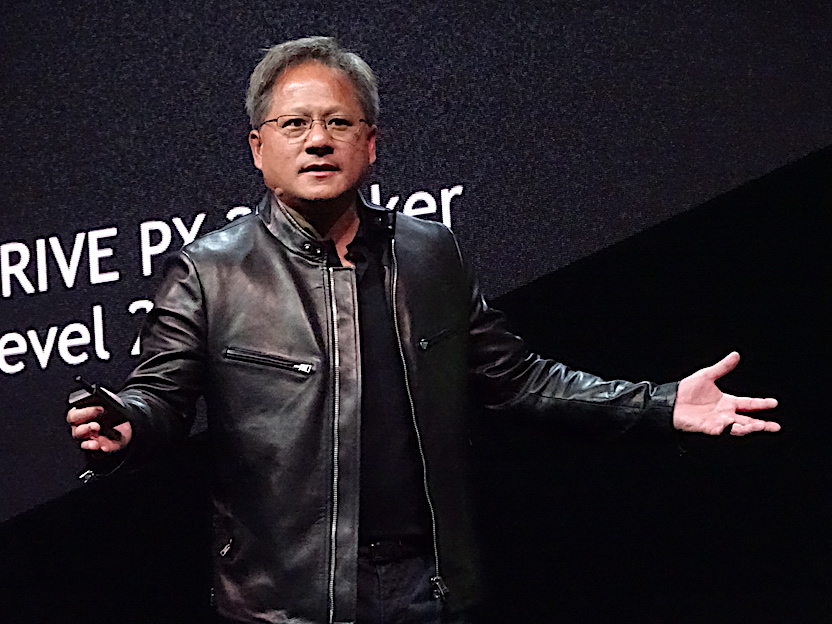 INFRA
INFRA
 INFRA
INFRA
 INFRA
INFRA
Artificial intelligence and cryptocurrency processing helped drive a ninth straight quarter of better-than-expected results for Nvidia Corp., but it wasn’t quite good enough to satisfy investors accustomed to the graphics chip maker’s frequent earnings outperformances.
The company, whose graphics processing unit chips are widely used to power gaming personal computers, data-crunching servers and new applications such as self-driving cars, reported a second-fiscal quarter net profit of $583 billion, or 92 cents a share, up 123 percent from a year ago. Revenue jumped 56 percent, to $2.23 billion.
Analysts had expected Nvidia to report a 70-cent profit, according to a Thomson Reuters survey on a 37 percent rise in revenue, so the results easily beat expectations.
The company issued a new forecast for $2.35 billion in revenue, plus or minus 2 percent, for the third quarter, along with a gross profit margin of between 58.6 and 58.8 percent. Analysts were expecting revenue of $2.13 billion.
But the report disappointed investors. In after-hours trading, shares were falling more than 6 percent. That’s on top of a 4 percent decline in regular trading, to $164.74 a share, on a day when the overall market was hit by concerns about President Trump’s saber-rattling versus North Korea. The reaction was a stark change from the 14 percent jump in share price when first-quarter earnings were reported, but shares have more than tripled in the past year.
Chief Executive Jensen Huang (pictured) said in a prepared statement that revenue from companies using GPUs in servers for AI and other tasks rose more than two and a half times from a year ago. “This is the era of AI, and the Nvidia GPU has become its brain,” he said.
However, from questions on the call, it appeared that analysts are expecting a slowdown in data center growth, which may have explained investors’ negative reaction to the report. Indeed, despite the year-over-year growth, revenue from data centers grew only 2 percent from the previous quarter, compared with a 38 percent sequential jump in the first quarter. Huang said he actually believes it was a strong quarter given a transition in the quarter to new data center chips.
Patrick Moorhead, president and principal analyst with Moor Insights & Strategy, cited a “very solid quarter” driven by Nvidia’s GeForce graphics chips as well as its Tesla data center processors and new Tegra mobile processors. One “blemish,” he said, was the discontinuation of a patent licensing agreement with Intel Corp.
“Nvidia will start to see a bit more competition in the gaming and machine learning category in the next two quarters, but I expect the company to still have a sizable raw performance lead with Volta-based GPUs,” its newest set of chips, he said.
Huang noted that chips configured for cryptocurrency “miners” that create bitcoin and other currencies accounted for a large part of the upside revenue surprise of about $250 million. Some $150 million of that upside was thanks to those cryptocurrency GPUs, he said.
“Cryptocurrency and blockchain are here to stay,” he said on the earnings call. “New currencies will come to market and the GPU is just fantastic at cryptography.”
Data center revenue, which had tripled last year, jumped 175 percent, to $416 million, also marking the eighth straight quarter of sequential sales increases. The customers are chiefly deep-learning leaders with so-called “hyperscale” data centers, such as Google Inc., Facebook Inc., Microsoft Corp., Amazon.com Inc. and IBM Corp., several of which provide access to GPU power online through their cloud computing services.
Nvidia could see more gains next quarter thanks to sales of its Volta Tesla V100 GPUs, of which Huang said Nvidia has already sold “a lot” in the second quarter. They’re designed to handle AI workloads, similar to other chips such as Alphabet Inc.’s tensor processing unit as well as coming chips from Intel and Microsoft Corp.
Revenue from gaming PCs, by far the company’s biggest segment, rose 52 percent, to $1.19 billion.
Not all of Nvidia’s operations are doing so well. Revenue from professional visualization for high-end rendering such as that used in virtual reality, rose 10 percent, to $235 million. Automotive rose 19 percent, to $142 million.
However, the original equipment manufacturer and intellectual property businesses, after falling last quarter, collectively saw a big 52 percent jump, to $251 million, thanks to the impact of the cryptocurrency chips.
Support our mission to keep content open and free by engaging with theCUBE community. Join theCUBE’s Alumni Trust Network, where technology leaders connect, share intelligence and create opportunities.
Founded by tech visionaries John Furrier and Dave Vellante, SiliconANGLE Media has built a dynamic ecosystem of industry-leading digital media brands that reach 15+ million elite tech professionals. Our new proprietary theCUBE AI Video Cloud is breaking ground in audience interaction, leveraging theCUBEai.com neural network to help technology companies make data-driven decisions and stay at the forefront of industry conversations.